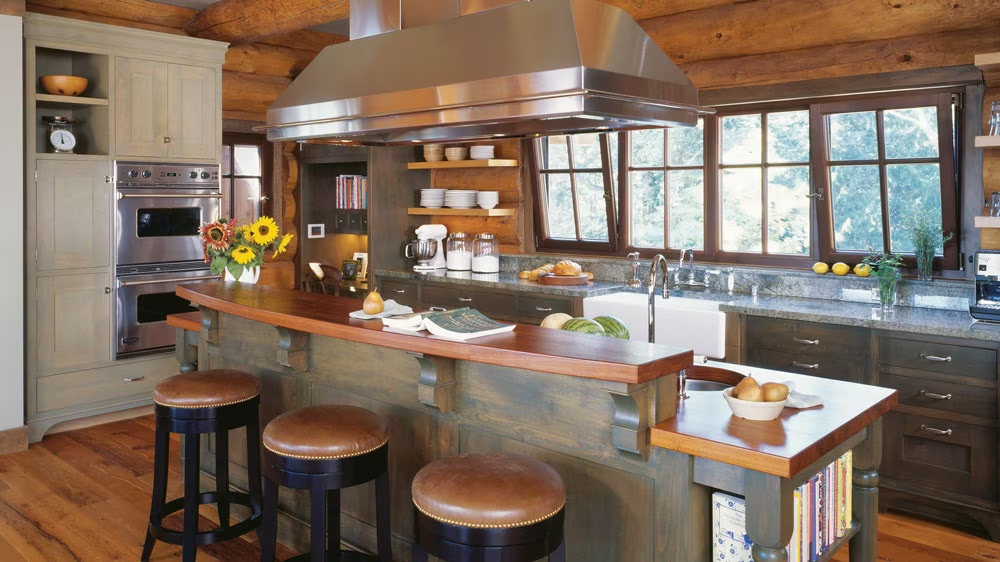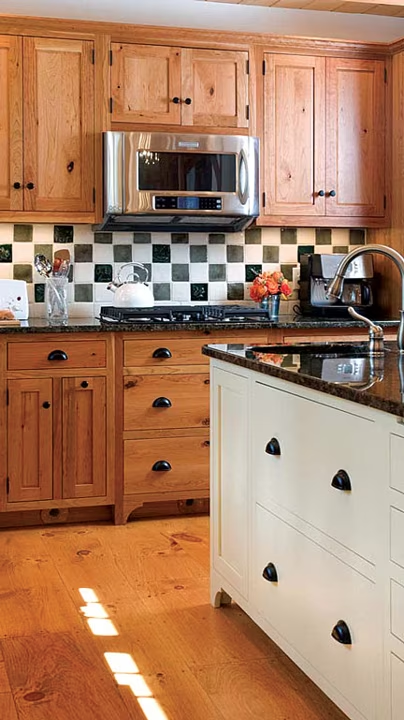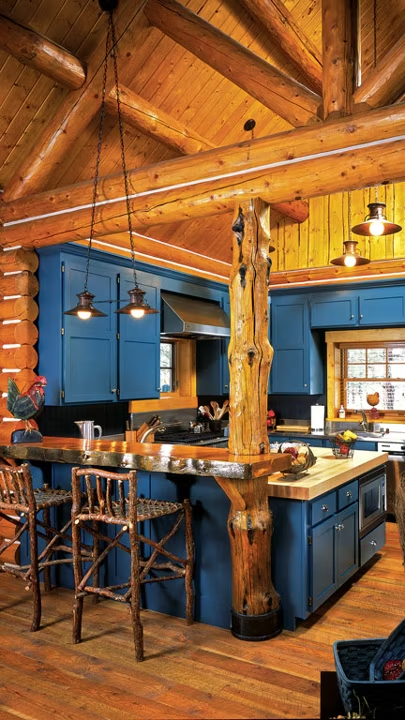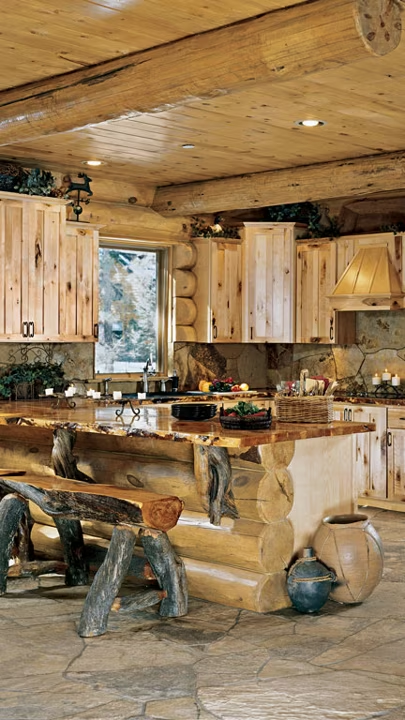Although cabinets might seem merely functional for storage, they are an important kitchen design element. Too many cabinets can overpower a small space. Darker-colored wood species might make a room feel cozy, but they also might make the room feel smaller and too dark. You might consider creating a separate pantry and minimizing upper cabinets to allow for more natural light through windows.
And, as kitchen and bath designer Doe Winslow, owner of Cottage Furniture in the Florida Keys (kbspecialists.com), says, “Cabinetry should look like it’s part of the architecture, built between the studs, that sort of thing. We wouldn’t come along and plop a fancy cabinet in front of the logs or the rustic tongue-and-groove. People want authenticity.”
Knot Good
Unless you’re planning to cut down nearby trees to create your cabin’s kitchen cabinets, you’ll need to do some research to find the right wood species and hardware for an authentic look. It can be more difficult to find a secondary cut of wood, “with the knots, worm and bug holes that give wood the character and rustic charm that cabin owners often want,” says Shawn Dahl, owner with his father George Dahl of Cook-Dahl Inc. in Brockport, New York, which specializes in cabinetry and kitchen design.
Secondary wood is usually sold for firewood. A primary cut, with its nice, clean grain, is what “the majority of people put in their kitchens,” Shawn says, but that may not fit aesthetically in a cabin kitchen. The wood species you choose depends on the cabin’s interior. Similarly stained structural timbers and cabinet wood make the cabinets appear to be an organic part of the space, Winslow notes. She sees a lot of cherry, oak, knotty pine, knotty hickory and knotty alder being used in rustic spaces.
“Hickory has a wild grain, with an open, erratic pattern with lots of knots,” says George Dahl. “Lots of cabinets were made with this in the ’70s, and it’s making a comeback. Oak has taken a backseat.”
Aging In Places
Keep in mind that all wood darkens over time. Shawn recommends clients “go natural and let the aging process do its thing.” But many people don’t want to wait, so the Dahls will stain the wood to get the right hue.
Reclaimed wood, which has already been cured and aged, can perfect a rustic look, but it can be more expensive than buying new. To get the old, worn patina, new cabinets can be distressed. “We sand the doors in the spots where, if they were old, they might have worn away over the years — the edges, around the door knobs,” Shawn says. He nicks door edges, beats cabinet faces with different tools to “try to copycat worm holes in the wood.” Then he glazes the wood to fill in the gouged-out areas and accentuate them. “It works best with cherry and alder — softer hardwoods.”
Although many glazes are oil based, there are a number of new water-based products that are low in volatile organic compounds (VOCs). They’ve gotten a bad rap in the past, but, Shawn says, the products have come a long way and will hold up as well as the oil-based or poly finishes with harsh solvents. “I like using the waterborne products now,” he says.
Box Step
Every cabin has its own unique building style, especially old cabins with walls that may have settled unevenly. But that doesn’t mean you have to purchase expensive custom cabinetry. Stock cabinets — the least expensive cabinetry option — come in two types: ready-to-assemble (RTA) or standard.
For RTA cabinets, you put together the sides, front, tops and bottoms, and screw the doors on the box. Standard cabinets are premade and usually come in 3-inch increments. You can find RTA or standard cabinets in many wood species. With semi-custom, you can mix and match wood species, finishes and, to some degree, door styles, Winslow explains. In a custom design, a designer can choose “every aspect of the cabinet, from width, height, depth, girth, hardware, style, species — everything is completely specified,” she adds.
Regardless of which type you choose, the cabinet box is typically the same, made of plywood. And unless you’re buying a solid hardwood door front, you’re getting a wood (or other material) veneer over the front. That’s what changes the cost of the cabinet. It also could be cost-effective to have cabinets refaced — removing existing cabinet doors and possibly the sides and applying new finishes, veneers or paints. “It’s best done by a specialist,” cautions Winslow.
Style And Substance
“The kinds of cabinets we’re selling now are minimalist — even in a rustic setting,” Winslow observes. “Shaker is the number one selling style by far in the U.S.” She’s also selling a lot of flat-front styles in part because they are easy to maintain — no crevices for dust and dirt to hide.
A natural style is important in rustic cabinet design and hardware; decorative hardware in particular — knobs, handles and exterior hinges — plays a role in creating that feel. The most popular hardware choices, Winslow says, are bronzes. She’s seeing a lot of metals used — copper in door panels or for sinks — and many with antique and forged finishes. With rustic design, “it’s all about natural materials, stone, metals, wood — elemental materials,” she states.








